Leora J. Goodin
I'm a blogger dedicated to sharing insights on lifestyle and wellness. Through personal stories and practical tips, I aim to inspire and empower my readers to lead healthier, more fulfilling lives.
Black Friday and Cyber Monday 2023 Deals for Motion Designers, grab it now!
Students and teachers save a massive 71% on Creative Cloud All Apps
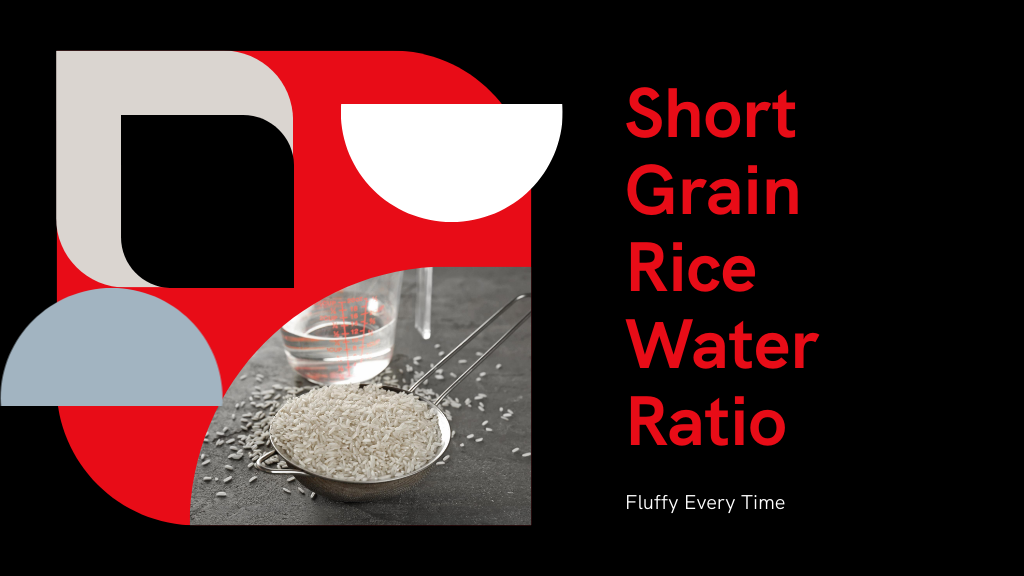
Get the perfect sticky texture with the ideal water ratio for short grain rice—discover the secret that transforms your cooking every time.
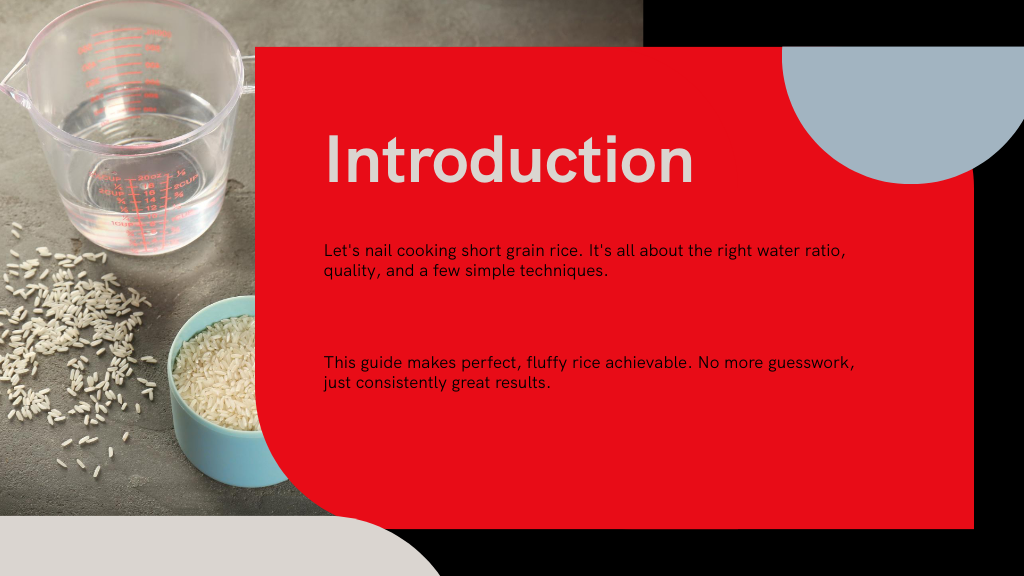
When cooking short grain rice, you’ll want to use about 1.1 to 1.2 times as much water by weight as rice to get that perfect tender, sticky texture. Rinsing the rice well helps remove excess starch, and soaking for 20 to 120 minutes improves water absorption. Using filtered water and steaming the rice after cooking locks in moisture and fluffiness. Keep these tips in mind, and you’ll soon master the ideal technique for flawless rice every time.
Short-grain rice, especially the Japanese Japonica variety, stands out for its short, plump shape and sticky texture when cooked. When learning how to cook short grain rice, you need to understand its unique characteristics. This variety has higher water content and lower amylose, making it tender and moist, with grains that cling without turning mushy.
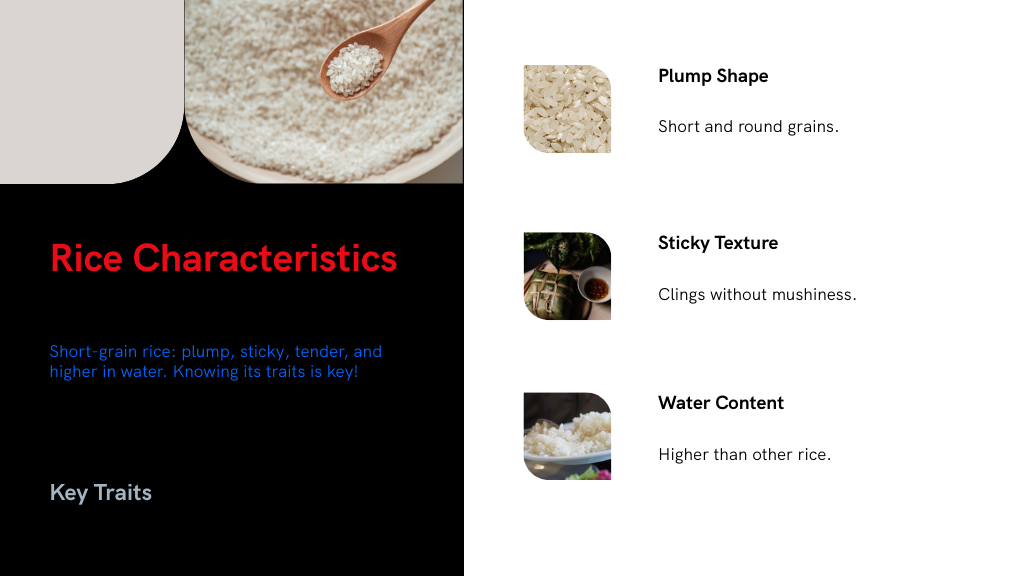
To get the right texture, paying attention to the short grain rice water ratio is essential. Typically, a ratio of 1:1.1 or 1:1.2 works best, ensuring the rice absorbs enough moisture for that perfect stickiness.
Also, rinsing the rice before cooking removes excess starch, improving flavor and preventing it from becoming overly sticky. Mastering these traits sets you up for delicious results every time.
Although cooking rice might seem straightforward, achieving the perfect texture depends on measuring your ingredients accurately.
Cooking rice is a precise chemical reaction, and the right rice-to-water ratio is key to getting that ideal consistency. Instead of guessing with volume measurements or finger methods, you should weigh your rice for better accuracy—small weight differences can seriously affect the outcome.
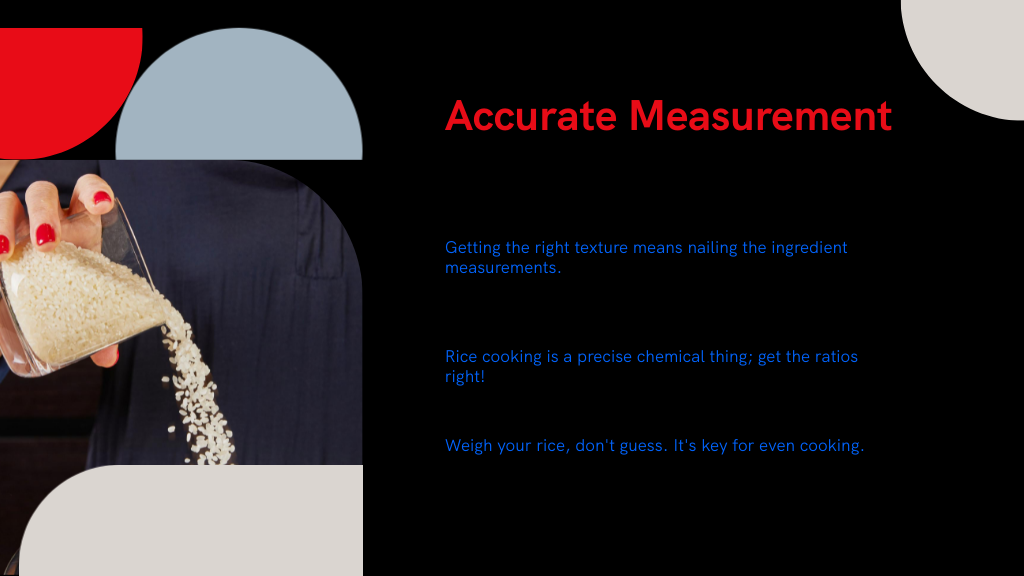
For short-grain rice, the recommended ratio is 1 gram of rice to 1.1 grams of water. This precision guarantees your rice cooks evenly and has the right texture.
When cooking short grain rice, the quality and temperature of your water play an essential role in the final taste and texture. You'll want to use filtered or spring water to avoid unwanted flavors and consider the mineral content, since hard water can affect how tender your rice turns out. Also, make sure the water isn’t too cold, as that can slow down cooking and impact results.
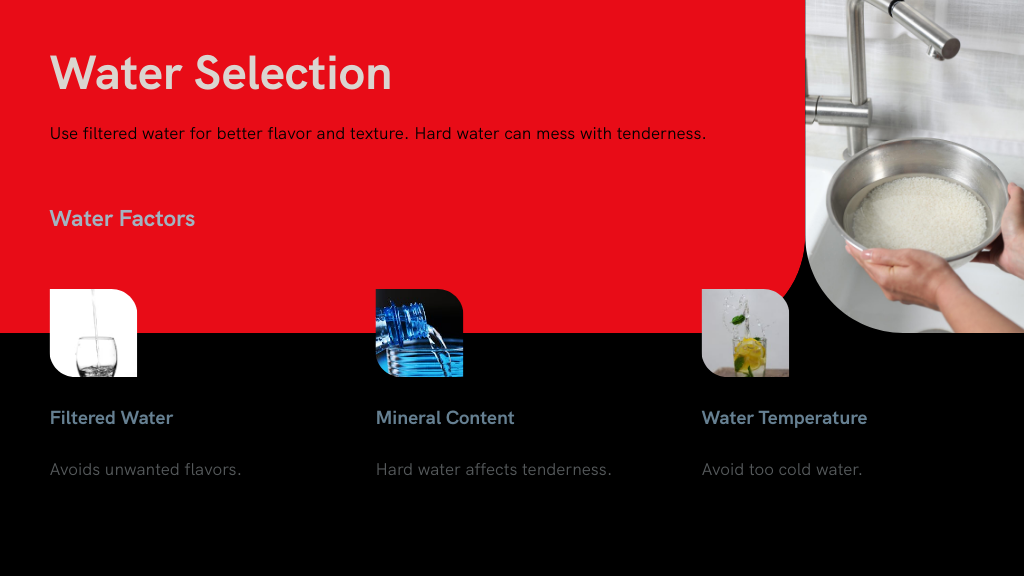
Since water makes up most of your cooked rice, its quality directly impacts the flavor and texture you get. Using filtered or bottled water is a smart choice, especially if your tap water has a strong chlorine taste or high mineral content that could alter the rice’s natural flavor.
Rinsing your rice with cold water before cooking not only removes excess starch but also guarantees the rice absorbs cleaner water, improving its texture. Clean, good-tasting water lets the rice cook evenly and enhances its subtle flavors.
Choosing the right water quality sets the foundation for great short grain rice, but the temperature of that water also plays a key role in your cooking success.
Before cooking, rinse your rice with cold running water to remove surface starch, which helps improve texture. You can even soak your rice in cold water at around 5℃ for about two hours to enhance consistency.
When it comes time to cook, use boiling water to guarantee even heat distribution and ideal absorption. This precise temperature helps your rice cook thoroughly and develop that signature sticky texture.
Although water temperature and ratio are essential, the mineral content in your water can greatly influence the flavor and texture of short grain rice. Softer water tends to produce rice with a delicate taste and firmer texture, while hard water, rich in calcium and magnesium, might cause a gritty feel.
To get the best results, you want water with balanced minerals—ideally a total dissolved solids (TDS) level between 50-150 mg/L. Using distilled or filtered water also helps by removing chlorine and impurities that could alter flavor. Remember, rinsing rice is vital, but the quality of your cooking water plays an equally important role.
Before cooking short grain rice, you’ll want to rinse it thoroughly under cold running water to remove excess starch and impurities. Use a gentle circular motion to avoid breaking the grains, and steer clear of metal strainers that might damage them. Typically, one to two washes are enough until the water runs almost clear.
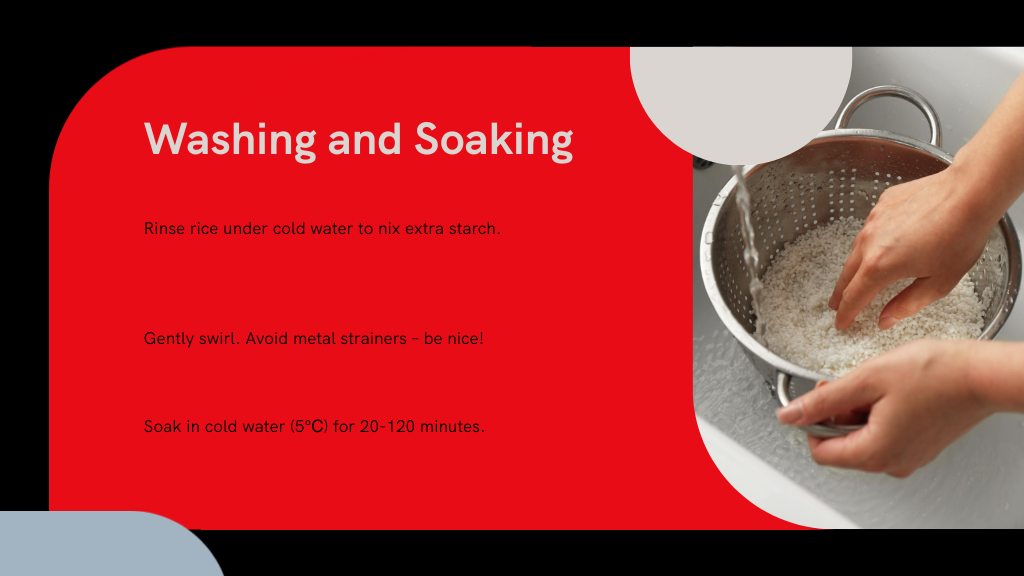
After rinsing, soak the rice fully submerged in water at around 5℃ for 20 to 120 minutes. This soaking step helps improve texture and cuts down cooking time by allowing the grains to absorb moisture evenly.
Soaking rice at 5℃ for 20 to 120 minutes enhances texture and reduces cooking time by evenly hydrating the grains.
Once soaked, drain the rice using a fine-mesh sieve for no longer than five minutes to prevent drying out before cooking. Proper washing and soaking set the foundation for perfectly cooked short grain rice.
When cooking short grain rice, getting the water-to-rice ratio right is key to achieving the perfect texture. Typically, you'll want to use between 1.1 to 1.2 cups of water for every 1 cup of rice. However, this changes depending on your cooking method and preferences.
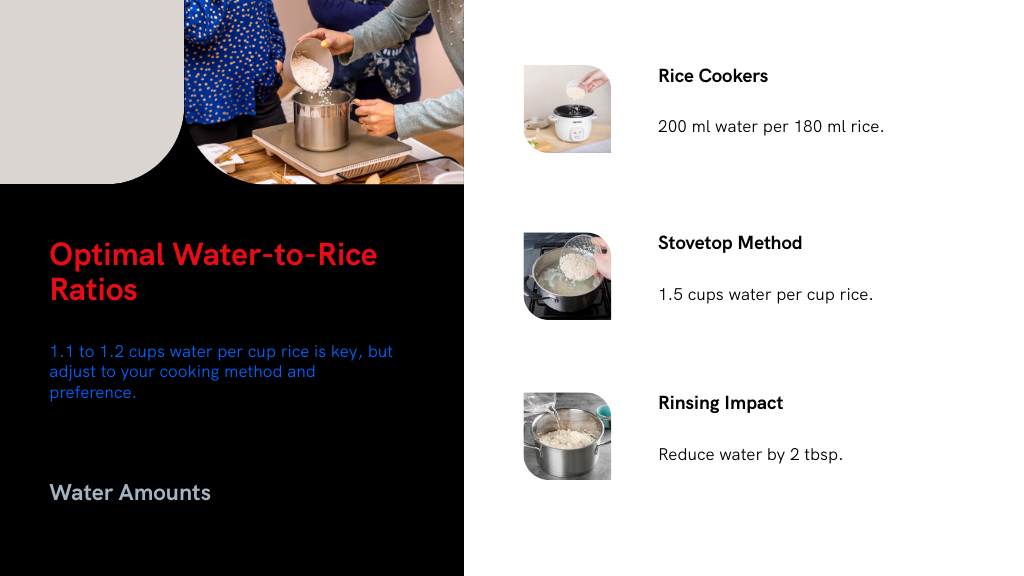
For rice cookers, use about 200 ml of water per 180 ml (1 cooker cup) of rice. On the stovetop, aim for roughly 1.5 cups of water per cup of rice to get the ideal softness. Rinsing your rice reduces the needed water by about 2 tablespoons per cup, as it removes excess starch.
Adjust water amounts based on specific rice brands and how firm or sticky you like your rice. Keep these ratios in mind to get consistent, delicious results every time.
To cook perfect short grain rice, you’ll start by washing and soaking the rice to remove excess starch and guarantee proper moisture absorption.
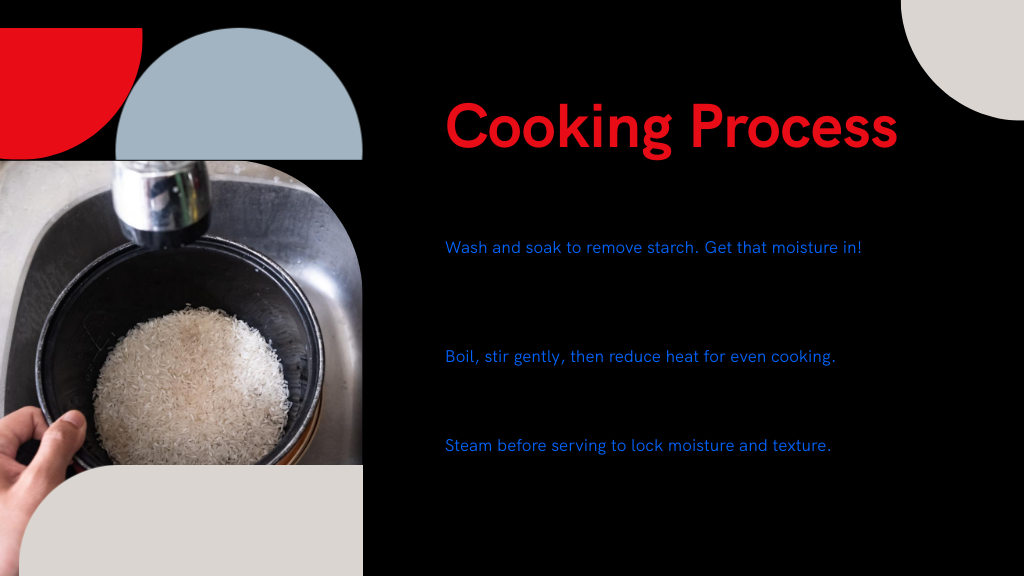
Next, you’ll bring the rice and water to a boil, stir gently, then reduce the heat to cook it evenly. Finally, letting the rice steam before serving locks in moisture and gives you that ideal texture.
Three simple steps can make a big difference in cooking perfect short grain rice: washing, soaking, and draining. First, rinse your rice under cold running water, gently agitating the grains for 10–15 seconds to remove dust and excess starch. Keep rinsing until the water runs nearly clear.
Next, soak the rinsed rice in cold water for 20 to 120 minutes, ideally around 5℃, to improve texture and absorption. Finally, drain the rice thoroughly using a fine-mesh sieve to prevent extra moisture before cooking.
After properly washing, soaking, and draining your short grain rice, you’re ready to move on to boiling and stirring. Start by bringing the water to a boil with the lid slightly ajar, allowing steam to escape—this usually takes 8 to 15 minutes on low heat.
Once boiling, remove the lid and gently stir the rice two to three times to guarantee even heat distribution without breaking the grains. Then, cover the pot tightly and reduce the heat to low, cooking for ten minutes so the rice absorbs the water fully.
Maintain an internal temperature around 98℃ (208.4°F) during cooking for the best texture and moisture. This careful boiling and stirring set the stage for perfectly cooked short grain rice.
Once the rice has finished cooking, you’ll want to let it steam with the lid on for 10 minutes so the moisture can evenly redistribute, ensuring the perfect texture. During this time, placing a damp kitchen towel between the pot and lid helps absorb extra moisture, preventing sogginess.
After steaming, gently fluff the rice with a dampened wooden spoon or rice paddle to keep the grains clumped just right for chopsticks.
When serving, transfer the rice to individual bowls, maintaining its fluffy yet cohesive texture. To keep it warm, cover the bowls loosely with a clean kitchen towel.
Although cooking short grain rice properly is important, steaming it afterward plays a vital role in achieving the perfect texture.
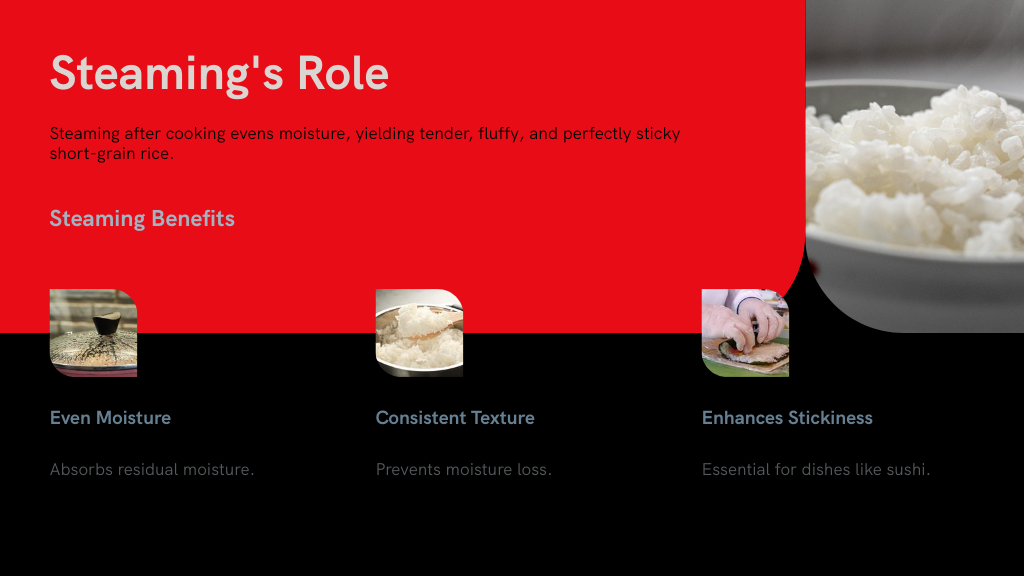
Steaming short grain rice after cooking is key to perfect texture and fluffiness.
When you steam the rice for about 10 minutes with the pot covered, you let residual moisture evenly absorb into the grains, making them tender and fluffy. Keeping the lid on traps steam, preventing moisture loss, and ensuring consistent texture throughout.
This resting period also maintains the rice’s internal temperature above 98℃ (208.4°F), allowing excess moisture to escape without overcooking.
Steaming enhances the natural stickiness of short grain rice, which is essential if you’re preparing dishes like sushi that need clumped grains.
Three common issues you'll face when cooking short grain rice are hardness at the bottom, gummy texture, and excess moisture. To fix hardness, adjust boiling and simmering times to match your stove’s performance. Avoid gummy rice by sticking to a rice-to-water ratio around 1:1.1 or 1:1.2. If the rice turns soggy, reduce water slightly and soak the rice beforehand for better absorption.
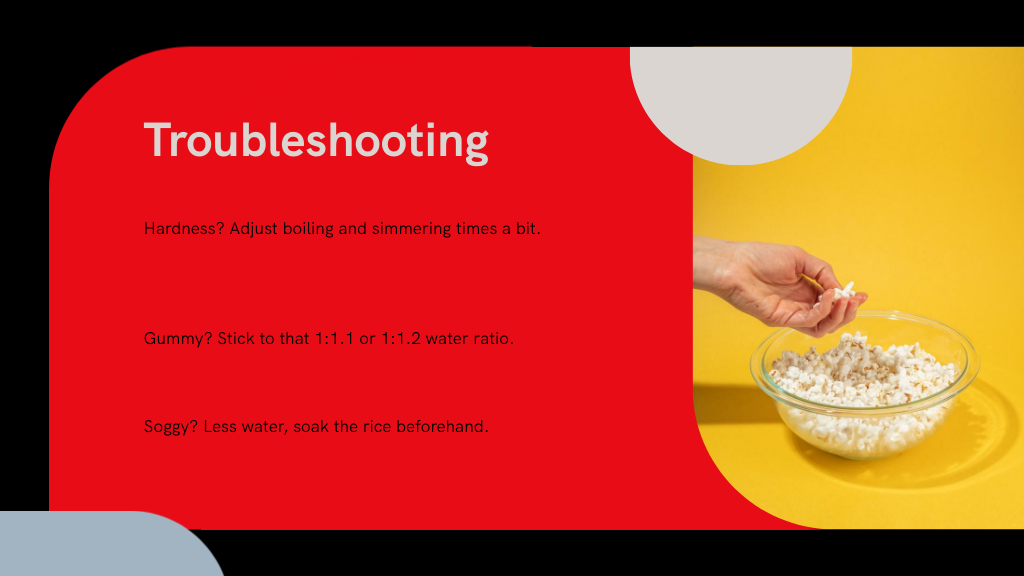
Now that you know the ideal water ratio and cooking tips for short grain rice, are you ready to get that perfect, fluffy texture every time? Remember, a little precision with water and patience during steaming can make all the difference. Don’t rush the process—your taste buds will thank you. So next time you cook, trust these guidelines and enjoy delicious, perfectly cooked short grain rice without any guesswork!
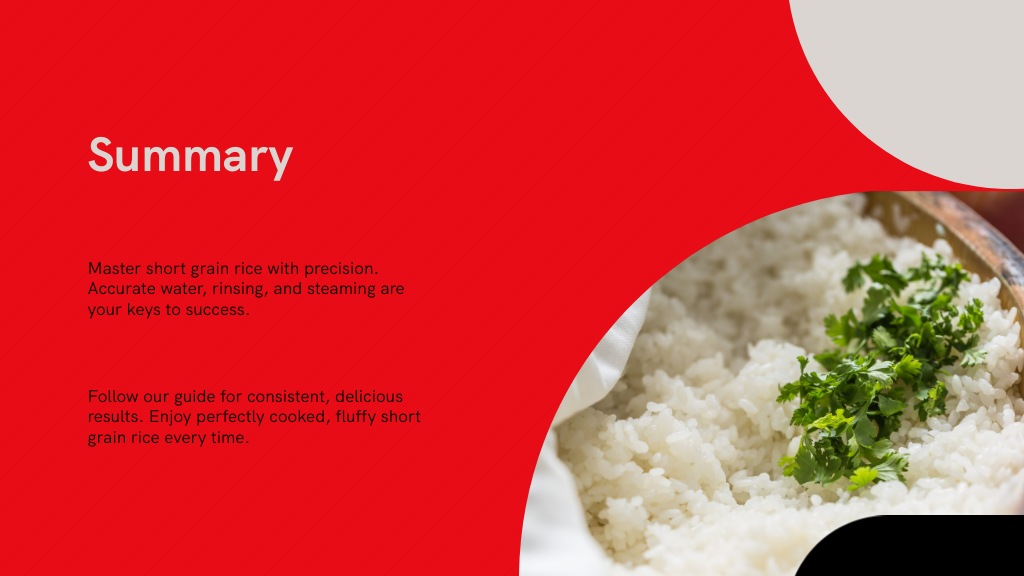
Your email address will not be published. Required fields are marked *